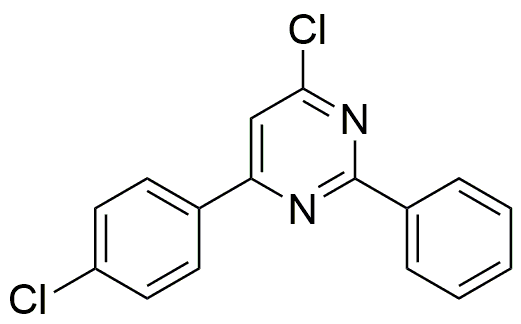4-Chloro-6-(4-chlorophenyl)-2-phenylpyrimidine is widely utilized in research focused on:
- Agricultural Chemistry: This compound serves as a key ingredient in developing herbicides, helping to control weed growth effectively while minimizing crop damage.
- Pharmaceutical Development: It is explored for its potential as an anti-cancer agent, with studies indicating its ability to inhibit specific cancer cell lines.
- Material Science: The compound is used in synthesizing advanced materials, including polymers that exhibit enhanced thermal stability and chemical resistance.
- Biochemical Research: Researchers utilize it to study enzyme inhibition, providing insights into metabolic pathways and potential therapeutic targets.
- Environmental Science: It plays a role in developing eco-friendly pesticides, aiming to reduce environmental impact while maintaining agricultural productivity.
Información general
Propiedades
Seguridad y normativas
Aplicaciones
4-Chloro-6-(4-chlorophenyl)-2-phenylpyrimidine is widely utilized in research focused on:
- Agricultural Chemistry: This compound serves as a key ingredient in developing herbicides, helping to control weed growth effectively while minimizing crop damage.
- Pharmaceutical Development: It is explored for its potential as an anti-cancer agent, with studies indicating its ability to inhibit specific cancer cell lines.
- Material Science: The compound is used in synthesizing advanced materials, including polymers that exhibit enhanced thermal stability and chemical resistance.
- Biochemical Research: Researchers utilize it to study enzyme inhibition, providing insights into metabolic pathways and potential therapeutic targets.
- Environmental Science: It plays a role in developing eco-friendly pesticides, aiming to reduce environmental impact while maintaining agricultural productivity.
Documentos
Hojas de datos de seguridad (HDS)
La SDS proporciona información de seguridad completa sobre la manipulación, el almacenamiento y la eliminación del producto.
Especificación del producto (PS)
La PS proporciona un desglose completo de las propiedades del producto, incluida la composición química, el estado físico, la pureza y los requisitos de almacenamiento. También detalla los rangos de calidad aceptables y las aplicaciones previstas del producto.
Certificados de análisis (COA)
Busque certificados de análisis (COA) ingresando el número de lote del producto. Los números de lote y de partida se pueden encontrar en la etiqueta de un producto después de las palabras "Lote" o "Lote".
Número de catálogo
Número de lote/lote
Certificados de origen (COO)
Este certificado de origen confirma el país en el que se fabricó el producto y también detalla los materiales y componentes utilizados en él y si se deriva de fuentes naturales, sintéticas u otras fuentes específicas. Este certificado puede ser necesario para cumplir con las normativas aduaneras, comerciales y regulatorias.
Número de catálogo
Número de lote/lote
Hojas de datos de seguridad (HDS)
La SDS proporciona información de seguridad completa sobre la manipulación, el almacenamiento y la eliminación del producto.
DownloadEspecificación del producto (PS)
La PS proporciona un desglose completo de las propiedades del producto, incluida la composición química, el estado físico, la pureza y los requisitos de almacenamiento. También detalla los rangos de calidad aceptables y las aplicaciones previstas del producto.
DownloadCertificados de análisis (COA)
Busque certificados de análisis (COA) ingresando el número de lote del producto. Los números de lote y de partida se pueden encontrar en la etiqueta de un producto después de las palabras "Lote" o "Lote".
Número de catálogo
Número de lote/lote
Certificados de origen (COO)
Este certificado de origen confirma el país en el que se fabricó el producto y también detalla los materiales y componentes utilizados en él y si se deriva de fuentes naturales, sintéticas u otras fuentes específicas. Este certificado puede ser necesario para cumplir con las normativas aduaneras, comerciales y regulatorias.


